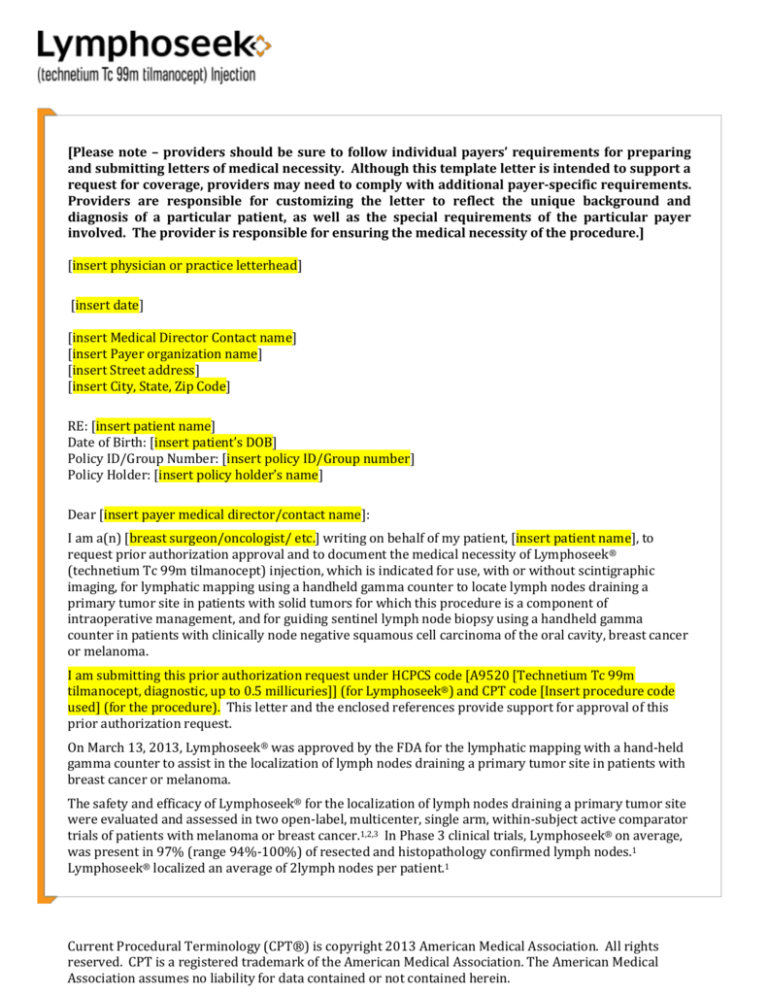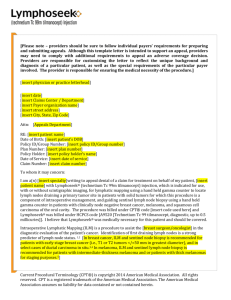
[Please note – providers should be sure to follow individual payers’ requirements for preparing
and submitting letters of medical necessity. Although this template letter is intended to support a
request for coverage, providers may need to comply with additional payer-specific requirements.
Providers are responsible for customizing the letter to reflect the unique background and
diagnosis of a particular patient, as well as the special requirements of the particular payer
involved. The provider is responsible for ensuring the medical necessity of the procedure.]
[insert physician or practice letterhead]
[insert date]
[insert Medical Director Contact name]
[insert Payer organization name]
[insert Street address]
[insert City, State, Zip Code]
RE: [insert patient name]
Date of Birth: [insert patient’s DOB]
Policy ID/Group Number: [insert policy ID/Group number]
Policy Holder: [insert policy holder’s name]
Dear [insert payer medical director/contact name]:
I am a(n) [breast surgeon/oncologist/ etc.] writing on behalf of my patient, [insert patient name], to
request prior authorization approval and to document the medical necessity of Lymphoseek®
(technetium Tc 99m tilmanocept) injection, which is indicated for use, with or without scintigraphic
imaging, for lymphatic mapping using a handheld gamma counter to locate lymph nodes draining a
primary tumor site in patients with solid tumors for which this procedure is a component of
intraoperative management, and for guiding sentinel lymph node biopsy using a handheld gamma
counter in patients with clinically node negative squamous cell carcinoma of the oral cavity, breast cancer
or melanoma.
I am submitting this prior authorization request under HCPCS code [A9520 [Technetium Tc 99m
tilmanocept, diagnostic, up to 0.5 millicuries]] (for Lymphoseek®) and CPT code [Insert procedure code
used] (for the procedure). This letter and the enclosed references provide support for approval of this
prior authorization request.
On March 13, 2013, Lymphoseek® was approved by the FDA for the lymphatic mapping with a hand-held
gamma counter to assist in the localization of lymph nodes draining a primary tumor site in patients with
breast cancer or melanoma.
The safety and efficacy of Lymphoseek® for the localization of lymph nodes draining a primary tumor site
were evaluated and assessed in two open-label, multicenter, single arm, within-subject active comparator
trials of patients with melanoma or breast cancer.1,2,3 In Phase 3 clinical trials, Lymphoseek® on average,
was present in 97% (range 94%-100%) of resected and histopathology confirmed lymph nodes.1
Lymphoseek® localized an average of 2lymph nodes per patient.1
Current Procedural Terminology (CPT®) is copyright 2013 American Medical Association. All rights
reserved. CPT is a registered trademark of the American Medical Association. The American Medical
Association assumes no liability for data contained or not contained herein.
In clinical trials, no serious adverse reactions were reported during clinical trials with Lymphoseek®. A
total of 553 with either breast cancer, melanoma, or squamous cell carcinoma of the oral cavity, skin and
lip have received Lymphoseek in open-label, single-arm clinical trials. No patients experienced serious
adverse reactions related to Lymphoseek. The most common adverse reactions in clinical trials (n = 553
patients) were:
Injection site irritation (4 patients; 0.7%)
Injection site pain: 0.2%; n = 1 of 542
Other adverse reactions were uncommon, and of mild severity and short duration
A full description of Lymphoseek risks is provided below.
Diagnostic efficacy was determined by the number of histology-confirmed lymph nodes detected by
Lymphoseek®. Lymphoseek® (50 mcg; 0.5 mCi) was injected into patients at least 15 minutes prior to the
scheduled surgery, and blue dye was injected shortly prior to initiation of the surgery. Intraoperative
lymphatic mapping was performed using a hand-held gamma detection probe followed by excision of
lymph nodes identified by Lymphoseek®, blue dye, or the surgeon’s visual and palpation examination. The
resected lymph nodes were sent for histopathology evaluation.1
In Study One, of 179 patients who received Lymphoseek®, 94 (53%) had known or suspected breast
cancer and 85 (48%) had known or suspected melanoma. The median age was 59 years (range 20 to 90
years) and most (72%) were women.1
In Study Two, of 153 patients who received Lymphoseek®, 77 (50%) had known or suspected breast
cancer and 76 (50%) had known or suspected melanoma. The median age was 61 years (range 26 to 88
years) and most (68%) were women.1
In 2014, FDA reviewed a third Phase 3 study evaluating the use of Lymphoseek® in SLN biopsy
procedures in 83 patients with squamous cell carcinoma (T1-T4a, no nodal or metastatic disease) of the
oral cavity (n=79, including 20 patients with floor of mouth tumors), skin (n=5), and lip (n=1). Diagnostic
efficacy was determined by the patient level false negative rate (FNR) of sentinel lymph node detection by
Lymphoseek® as confirmed by pathologic assessment of lymph nodes removed during a required
elective neck dissection. 97.6% of patients had at least one SLN identified.4 Pathology-positive lymph
nodes were found in 39 patients, all of whom had squamous cell carcinoma of the oral cavity. Only 2.6%
of patients with pathology positive lymph nodes were not identified by Lymphoseek (per patient FNR =
2.6%). Lymphoseek® also demonstrated a high negative predictive value—98% of patients identified as
pathology-negative by Lymphoseek® were confirmed as true negative by END. 4, 5
In short, it was demonstrated in clinical trials that Lymphoseek-guided SLN biopsy accurately determines
if the cancer has spread through the lymphatic system.6 SLN biopsy procedures may allow for the option
of more limited lymph node surgery in patients with sentinel nodes negative for cancer.4,6
For additional information regarding Lymphoseek, please visit www.lymphoseek.com or call Navidea at
1-800-476-5270. If you have additional questions regarding this specific procedure or patient, please
contact (insert physician contact information here).
Current Procedural Terminology (CPT®) is copyright 2013 American Medical Association. All rights
reserved. CPT is a registered trademark of the American Medical Association. The American Medical
Association assumes no liability for data contained or not contained herein.
[Mr./Ms./Mrs.] [insert patient’s last name] is a [insert age] year old [female/male] who has [breast
cancer/malignant melanoma/SCC of oral cavity/solid tumor] (ICD-9-CM [insert ICD-9 codes]).
[Mr./Ms./Mrs.] [insert patient’s last name] presented to me on [insert date] with [details such as physical
exam results and clinical impressions]. [Mr./Ms./Mrs.] [insert patient’s last name] is a candidate for
Lymphoseek® (technetium Tc 99m tilmanocept) injection, indicated for use, with or without scintigraphic
imaging, for lymphatic mapping, using a handheld gamma counter, to locate lymph nodes draining a
primary tumor site in patients with solid tumors for which this procedure is a component of
intraoperative management, and for guiding sentinel lymph node biopsy using a handheld gamma
counter in patients with clinically node negative squamous cell carcinoma of the oral cavity, breast cancer
or melanoma. [If other localization products were used or considered prior to Lymphoseek®, would add:
Other therapies [tried/considered] as part of the localization of [Mr./Mrs./Ms.] [insert patient’s last
name]’s lymph nodes included [describe other products]. However, [provide rationale for using
Lymphoseek® as compared to comparator products, or why it was used following a comparator product].]
I request confirmation that this procedure is a covered benefit based on medical necessity, and that
associated fees will be covered. Thank you for your review of this information and for your coverage
consideration. If you have any questions or require additional information, please contact me at [insert
physician’s contact information].
Sincerely,
[Physician Signature]
[Physician’s full name]
[Address]
[Telephone number]
Current Procedural Terminology (CPT®) is copyright 2013 American Medical Association. All rights
reserved. CPT is a registered trademark of the American Medical Association. The American Medical
Association assumes no liability for data contained or not contained herein.
Indication:
Lymphoseek (technetium Tc 99m tilmanocept) injection is indicated with or without scintigraphic
imaging for:
Lymphatic mapping using a handheld gamma counter to locate lymph nodes draining a primary
tumor site in patients with solid tumors for which this procedure is a component of intraoperative
management.
Guiding sentinel lymph node biopsy using a handheld gamma counter in patients with clinically
node negative squamous cell carcinoma of the oral cavity, breast cancer or melanoma
Important Safety Information:
In clinical trials with Lymphoseek, no serious hypersensitivity reactions were reported, however
Lymphoseek may pose a risk of such reactions due to its chemical similarity to dextran. Serious
hypersensitivity reactions have been associated with dextran and modified forms of dextran (such as iron
dextran drugs).
Prior to the administration of Lymphoseek, patients should be asked about previous hypersensitivity
reactions to drugs, in particular dextran and modified forms of dextran. Resuscitation equipment and
trained personnel should be available at the time of Lymphoseek administration, and patients observed
for signs or symptoms of hypersensitivity following injection.
Any radiation-emitting product may increase the risk for cancer. Adhere to dose recommendations and
ensure safe handling to minimize the risk for excessive radiation exposure to patients or health care
workers.
In clinical trials, no patients experienced serious adverse reactions and the most common adverse
reactions were injection site irritation and/or pain (<1%).
References
1. LYMPHOSEEK® Injection Package Insert. Dublin, OH: Navidea Biopharmaceuticals, Inc., Dublin OH;
October 2014.
2. Sondak VK, King DW, Zager J, et al Combined analysis of Phase III trials evaluating
[99mTc]Tilmanocept and vital blue dye for identification of sentinel lymph nodes in clinically nodenegative cutaneous melanoma. Ann Surg Oncol 2013;20:680-8.
3. Wallace AM, Han LK, Povoski SP, et al. Comparative evaluation of [99mTc] Tilmanocept for sentinel
node mapping in breast cancer patients: results of two phase 3 trials. Ann Surg Oncol. 2013;20:25909.
4. Data on file, Navidea Biopharmaceuticals, Inc. Dublin, OH. Sept 2014
5. Lai SW. Receptor-targeted 99mTc-tilmanocept for sentinel lymph node biopsy (SLNB) in HNSCC:
predictive utility vs. elective neck dissection. Presented at 6th European Congress on Head and Neck
Oncology. Liverpool, UK. April 24-26, 2014. Abstract.
6. FDA news release. FDA approved Lymphoseek to help determine the extent of head and neck cancer
in the body. Available at:
http://www.fda.gov/NewsEvents/Newsroom/PressAnnouncements/ucm401085.htm. Accessed
September 17, 2014.
Current Procedural Terminology (CPT®) is copyright 2013 American Medical Association. All rights
reserved. CPT is a registered trademark of the American Medical Association. The American Medical
Association assumes no liability for data contained or not contained herein.










